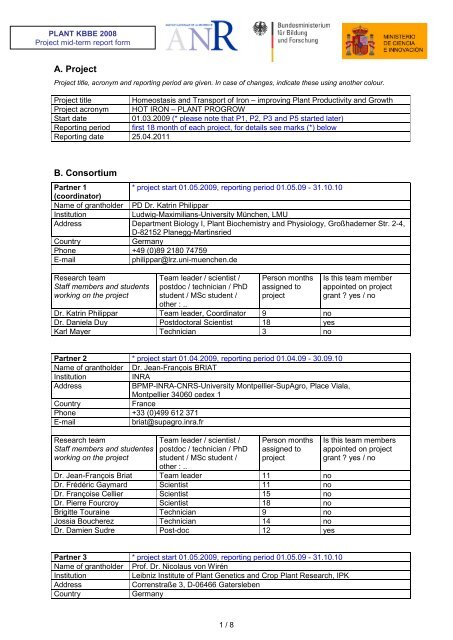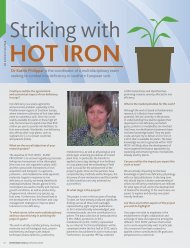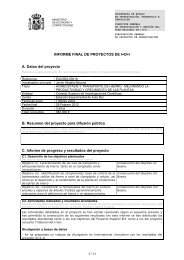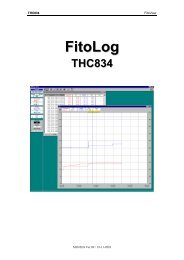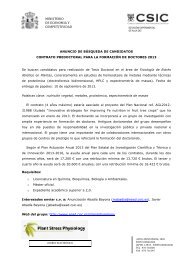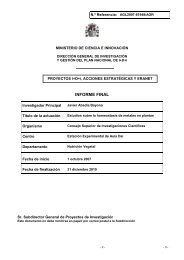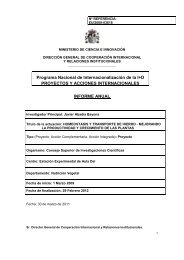Reporting form ERA-PG mid-term - Plant Stress Physiology
Reporting form ERA-PG mid-term - Plant Stress Physiology
Reporting form ERA-PG mid-term - Plant Stress Physiology
You also want an ePaper? Increase the reach of your titles
YUMPU automatically turns print PDFs into web optimized ePapers that Google loves.
PLANT KBBE 2008<br />
Project <strong>mid</strong>-<strong>term</strong> report <strong>form</strong><br />
A. Project<br />
Project title, acronym and reporting period are given. In case of changes, indicate these using another colour.<br />
Project title<br />
Homeostasis and Transport of Iron – improving <strong>Plant</strong> Productivity and Growth<br />
Project acronym HOT IRON – PLANT PROGROW<br />
Start date<br />
01.03.2009 (* please note that P1, P2, P3 and P5 started later)<br />
<strong>Reporting</strong> period first 18 month of each project, for details see marks (*) below<br />
<strong>Reporting</strong> date 25.04.2011<br />
B. Consortium<br />
Partner 1<br />
* project start 01.05.2009, reporting period 01.05.09 - 31.10.10<br />
(coordinator)<br />
Name of grantholder PD Dr. Katrin Philippar<br />
Institution<br />
Ludwig-Maximilians-University München, LMU<br />
Address Department Biology I, <strong>Plant</strong> Biochemistry and <strong>Physiology</strong>, Großhaderner Str. 2-4,<br />
D-82152 Planegg-Martinsried<br />
Country<br />
Germany<br />
Phone +49 (0)89 2180 74759<br />
E-mail<br />
philippar@lrz.uni-muenchen.de<br />
Research team<br />
Staff members and students<br />
working on the project<br />
Team leader / scientist /<br />
postdoc / technician / PhD<br />
student / MSc student /<br />
other : ..<br />
Person months<br />
assigned to<br />
project<br />
Dr. Katrin Philippar Team leader, Coordinator 9 no<br />
Dr. Daniela Duy Postdoctoral Scientist 18 yes<br />
Karl Mayer Technician 3 no<br />
Is this team member<br />
appointed on project<br />
grant ? yes / no<br />
Partner 2 * project start 01.04.2009, reporting period 01.04.09 - 30.09.10<br />
Name of grantholder Dr. Jean-François BRIAT<br />
Institution<br />
INRA<br />
Address<br />
BPMP-INRA-CNRS-University Montpellier-SupAgro, Place Viala,<br />
Montpellier 34060 cedex 1<br />
Country<br />
France<br />
Phone +33 (0)499 612 371<br />
E-mail<br />
briat@supagro.inra.fr<br />
Research team<br />
Staff members and studentes<br />
working on the project<br />
Team leader / scientist /<br />
postdoc / technician / PhD<br />
student / MSc student /<br />
other : ..<br />
Person months<br />
assigned to<br />
project<br />
Dr. Jean-François Briat Team leader 11 no<br />
Dr. Frédéric Gaymard Scientist 11 no<br />
Dr. Françoise Cellier Scientist 15 no<br />
Dr. Pierre Fourcroy Scientist 18 no<br />
Brigitte Touraine Technician 9 no<br />
Jossia Boucherez Technician 14 no<br />
Dr. Damien Sudre Post-doc 12 yes<br />
Is this team members<br />
appointed on project<br />
grant ? yes / no<br />
Partner 3 * project start 01.05.2009, reporting period 01.05.09 - 31.10.10<br />
Name of grantholder Prof. Dr. Nicolaus von Wirén<br />
Institution<br />
Leibniz Institute of <strong>Plant</strong> Genetics and Crop <strong>Plant</strong> Research, IPK<br />
Address<br />
Correnstraße 3, D-06466 Gatersleben<br />
Country<br />
Germany<br />
1 / 8
PLANT KBBE 2008<br />
Project <strong>mid</strong>-<strong>term</strong> report <strong>form</strong><br />
Phone +49 (0)39482 5602<br />
E-mail<br />
vonwiren@ipk-gatersleben.de<br />
Research team<br />
Staff members and studentes<br />
working on the project<br />
Team leader / scientist /<br />
postdoc / technician / PhD<br />
student / MSc student /<br />
other : ..<br />
Person months<br />
assigned to<br />
project<br />
Prof.Dr. Nicolaus von Wirén Project leader 1,5 no<br />
Nicole Beate Sch<strong>mid</strong> PhD student 18 yes<br />
Seckin Eroglu PhD student 0 yes<br />
Dr. Rongli Shi Postdoc 3 no<br />
Is this team members<br />
appointed on project<br />
grant ? yes / no<br />
Partner 4 * project start 01.03.2009, reporting period 01.03.09 - 31.08.10<br />
Name of grantholder Prof. Dr. Javier Abadia<br />
Institution<br />
Estación Experimental de Aula Dei (CSIC)<br />
Address<br />
Dept. <strong>Plant</strong> Nutrition, Av. Montañana 1005, E-50080 Zaragoza<br />
Country<br />
Spain<br />
Phone +34/(0)976-716056<br />
E-mail<br />
jabadia@eead.csic.es<br />
Research team<br />
Staff members and studentes<br />
working on the project<br />
Team leader / scientist /<br />
postdoc / technician / PhD<br />
student / MSc student /<br />
other : ..<br />
Person months<br />
assigned to<br />
project<br />
Prof. Dr. Javier Abadia Team leader 10 no<br />
Dr. Anunciación Abadía Scientist 10 no<br />
Dr. Ana Álvarez Scientist 10 no<br />
Dr. Yolanda Gogorcena Scientist 10 no<br />
Dr. Vázquez Reina Postdoc 10 no<br />
Dr. Rubén Rellán Álvarez Postdoc 18 (1/8/09-31/8/10) yes<br />
Jorge Rodríguez Celma PhD student 10 no<br />
Giuseppe Lattanzio PhD student 10 no<br />
Is this team members<br />
appointed on project<br />
grant ? yes / no<br />
Partner 5 * project start 01.07.2009, reporting period 01.07.09 - 31.12.10<br />
Name of grantholder José María García-Mina Freire<br />
Institution<br />
CIPAV R&D TIMAC AGRO ESPAÑA, ROULLIER GROUP<br />
Address<br />
Polígono Arazuri-Orcoyen, C/C, No. 32. 11407, Orcoyen (Navarra)<br />
Country<br />
Spain<br />
Phone +34 948 324 500<br />
E-mail<br />
jgmina@timacagro.es<br />
Research team<br />
Staff members and studentes<br />
working on the project<br />
Team leader / scientist /<br />
postdoc / technician / PhD<br />
student / MSc student /<br />
other : ..<br />
Person months<br />
assigned to<br />
project<br />
José Mª García-Mina Project leader 6,42 Yes<br />
Angel Mª Zamarreño Researcher 4,42 Yes<br />
Roberto Baigorri Researcher 6,72 Yes<br />
Marta Fuentes Researcher 2,50 Yes<br />
Eva Bacaicoa Researcher 13,80 Yes<br />
Sara San Francisco Researcher 10,55 Yes<br />
María Garnica Researcher 13,35 Yes<br />
Javier Erro Researcher 3,50 Yes<br />
Esther Casanova Researcher 4,95 Yes<br />
Is this team members<br />
appointed on project<br />
grant ? yes / no<br />
2 / 8
PLANT KBBE 2008<br />
Project <strong>mid</strong>-<strong>term</strong> report <strong>form</strong><br />
C. Project summary for public dissemination<br />
Provide an updated project summary including the progress of the project of 150 – 300 words for<br />
public dissemination. The summary could be published and can be used for other websites (e.g. the<br />
sites of the national funding organisations) and within publications such as the <strong>mid</strong>-<strong>term</strong> report of the<br />
PLANT KBBE 2008 programme.<br />
Iron is one of the most abundant metals on the earth’s crust. However, its redox properties make it an<br />
element with low bioavailability, particularly in basic soil. Approximately 30% of the world’s arable soils<br />
are thus iron deficient and because plants represent the major source for iron in human nutrition<br />
almost 25% of the world population is affected by iron deficiency, a leading cause of anemia. In plants,<br />
iron deficiency results in severe chlorosis as well as reduced productivity and quality of crops. This<br />
essential element is involved in several vital processes such as photosynthesis, respiration, sulphur<br />
and nitrogen assimilation and chlorophyll catabolism. Nevertheless this redox metal has a high<br />
reactivity and can generate the <strong>form</strong>ation of reactive oxygen species (ROS). Therefore, iron<br />
homeostasis has to be tightly regulated to prevent oxidative stress. The photosynthetic machinery,<br />
which is localised in chloroplasts, requires high iron for electron transport. Thus, chloroplasts<br />
represent a plat<strong>form</strong> controlling iron homeostasis (transport and storage) at the cellular level.<br />
However, molecular processes controlling iron homeostasis in chloroplasts are still unknown and<br />
might affect plant productivity under iron excess or deficiency.<br />
With the permease PIC1 (Fe-transport) and ferritin (Fe-storage) the project HOT IRON works on key<br />
components of chloroplast iron homeostasis in the model plant Arabidopsis thaliana. It was shown that<br />
function of both proteins is essential for plant productivity and seed yield. Coordinated screening of<br />
mutants (transcriptomics, metabolomics, proteomics and phenotyping) under iron deficiency and<br />
overload is used to identify new players involved in crosstalk between iron and ROS metabolism in<br />
leaves. First results point to the involvement of a chloroplast ABC-transporter. For transfer to crop<br />
species, the corresponding genes have been identified in peach and cucumber. Results will be used<br />
to modify and improve processes controlling productivity, growth and yield of these crop species.<br />
D. Progress report<br />
D1. Achievement of planned objectives<br />
List the objectives and estimate the current degree of completion of the objectives.<br />
OBJECTIVES<br />
(i)1: Microarray and mutant based screen to identify new<br />
key players linking iron homeostasis and transport.<br />
(i)2: Screening for membrane transporters of Fe III<br />
chelates.<br />
(i)3: Screening for genes improving growth of<br />
Arabidopsis lines on a calcareous substrate.<br />
(i)4: Identification of factors limiting iron<br />
retranslocation and distribution during plant senescence.<br />
(i)5: Subcellular localisation of the proteins identified in<br />
screens (i)1-(i)4.<br />
(ii)1: Phenotypical analysis of iron homeostasis mutants.<br />
(ii)2: Characteristics of iron transport across membranes<br />
analysed by SURFE 2 R technique.<br />
(iii)1: Identification of orthologous genes in peach and<br />
cucumber.<br />
(iii)2: Changes at the transcriptional, protein and<br />
metabolite levels of major iron homeostasis players<br />
in iron-sufficient, iron-deficient and iron-rich plants.<br />
(iii)3: Spatial localisation of iron in Fe-rich as well as<br />
chlorotic materials.<br />
PROGRESS TO OBJECTIVES<br />
Screen completed and new genes<br />
identified by April 2011.<br />
cDNA library made and isolation of an<br />
inositol transporter improving yeast growth<br />
on low Fe. Approach stopped.<br />
Screening on calcareous soil started in<br />
April 2010 and is still in progress. 2<br />
mutants isolated. Second screening on<br />
Fe-deficient agar started in January 2011.<br />
Fe retranslocation studies in senescing<br />
barley completed.<br />
Finished for first proteins, constantly<br />
supplemented with new players.<br />
Analysis finished for ferritin, pic1 mutants.<br />
Ongoing analysis for new players.<br />
Establishment of technique started in<br />
September 2010.<br />
Finished, constantly supplemented with<br />
new players.<br />
Transcriptomics finished, proteomics and<br />
metabolomics are ongoing (possible finish<br />
in December 2011).<br />
Techniques are established, experiments<br />
started.<br />
3 / 8
PLANT KBBE 2008<br />
Project <strong>mid</strong>-<strong>term</strong> report <strong>form</strong><br />
(iii)4: Design of new iron fertilisers.<br />
Design of new Fe fertilizers started, will<br />
accompany project until the end of funding<br />
period.<br />
D2. Activities<br />
Describe the activities that have been per<strong>form</strong>ed to meet the objectives given in the proposal. Indicate<br />
for each activity the partners involved (PX, PY,..).<br />
For consortia with three or four partners this item should not exceed two pages. Larger consortia may<br />
use at maximum three pages.<br />
(i)1: Screen to identify new key players linking iron homeostasis and transport.<br />
- Microarray experiments on three different mutant plants under three different conditions have been<br />
per<strong>form</strong>ed and analysed (P1, P2).<br />
- A database has been constructed to integrate and distribute results (P1, P4).<br />
- With the chloroplast membrane localised ABC transporter ATH12 a candidate, which could be<br />
involved in iron chloroplast export was integrated into the project (P2).<br />
(i)2: Screening for membrane transporters of Fe III chelates by yeast complementation.<br />
- cDNA library made from Fe-deficient Arabidopsis plants and isolation of an inositol transporter gene<br />
(AtINT1) improving yeast growth under Fe deficiency. However, knock-out and overexpression in<br />
Arabidopsis without phenotype (P3).<br />
- Establishment of screening conditions for Arabidopsis mutant lines on agar (P3).<br />
(i)3: Screening for genes improving growth of Arabidopsis lines on a calcareous substrate.<br />
- Screening conditions were optimised, screening started in April 2010 (P3).<br />
- Selection of some promising candidate lines and confirmation of Fe deficiency-induced chlorosis by<br />
Fe resupply (P3).<br />
- Confirmation of observed phenotype on Fe-deficient agar media by chlorophyll de<strong>term</strong>inations,<br />
assessment of root morphology and Fe uptake analysis (P3).<br />
(i)4: Identification of factors limiting iron retranslocation and distribution.<br />
- Iron tracing in plants using stable Fe isotopes (P4).<br />
- Xylem and phloem sap and root metabolomic and proteomic studies (P4, P5).<br />
(i)5: Subcellular localisation of the proteins identified in screens (i)1-(i)4.<br />
- Proteins (PIC1, FER, MATE, ABC transporter) have been localised by GFP and immunoblot<br />
analysis (P1, P2).<br />
(ii)1: Phenotypical analysis of iron homeostasis mutants.<br />
- Phenotypes of iron homeostasis mutants (pic1, fer, ath12) have been analysed under Fe-sufficient,<br />
Fe-deficient, and Fe-rich conditions (P1, P2, P3, P4).<br />
- Due to difficulties with existing PIC1 mutants, we started generating conditional PIC1 mutants (P1).<br />
(ii)2: Characteristics of iron transport across membranes analysed by SURFE 2 R technique.<br />
- Since Oktober 2010, the SURFE 2 R technique is established in the laboratory of P1.<br />
(iii)1: Identification of orthologous genes in peach and cucumber.<br />
- Orthologous genes to key players in Fe homoeostasis and transport have been identified in peach<br />
and integrated into the database (P4).<br />
- In cucumber, genes corresponding to Fe-transport and homeostasis are used as controls in<br />
experiments of P5.<br />
(iii)2: Changes at the transcriptional, protein and metabolite levels of major iron homeostasis players in<br />
iron-sufficient, iron-deficient and iron-rich plants.<br />
- Conditions to grow plants under Fe-sufficiency, -deficiency, and –excess have been tested and<br />
established for large scale analysis (P2, P3).<br />
- Microarray analysis for transcript changes have been per<strong>form</strong>ed (P1, P2).<br />
- Samples of the respective mutants have been collected and prepared for metabolic and proteomic<br />
analysis (P1, P2, P4).<br />
- Chloroplasts of plants grown in iron excess, iron deficiency and in control condition as well were<br />
extracted and prepared for proteomic and ionomic approach (P2, P4).<br />
- Chloroplast envelope proteins have been subjected to proteome analysis (P1, P4).<br />
- The role of hormones in Fe-deficiency induced responses has been studied (P5).<br />
(iii)3: Spatial localisation of iron in Fe-rich as well as chlorotic materials.<br />
- Spatial localization of Fe in leaves has been studied using Perl’s stain and µ-PIXE techniques (P4).<br />
4 / 8
PLANT KBBE 2008<br />
Project <strong>mid</strong>-<strong>term</strong> report <strong>form</strong><br />
(iii)4: Design of new iron fertilisers.<br />
- Preliminary works to carry out tests with new Fe fertilizers were developed (P4, P5; starting date<br />
month 18).<br />
D3. Problems and changes in workplan<br />
Describe any difficulties and problems that have hindered the achievement of the planned objectives<br />
and any changes with respect to the original objectives and the workplan (maximum 1 page).<br />
(i)2: Screening for membrane transporters of Fe III chelates by yeast complementation.<br />
The workplan is behind schedule, because one PhD student left the project due to health reasons,<br />
however, a new PhD candidate (S. Eroglu) has been found who started in October 2010.<br />
Since the isolated gene AtINT1only yielded a strong phenotype in yeast but not in planta, the yeast<br />
complementation approach was stopped and replaced by a screening approach for Arabidopsis<br />
mutant collections on Fe-deficient agar.<br />
(i)3: Screening for genes improving growth of Arabidopsis lines on a calcareous substrate.<br />
Because only a limited number of seeds was provided by gene stocks (NASC Nottingham) for<br />
screening Arabidopsis mutant pools a timely confirmation of phenotypes of potential candidates was<br />
delayed, as seeds need to be amplified prior to detailed analysis (P3).<br />
The screening procedures takes longer than expected, because composition of substrate is variable<br />
and requires re-calibration of screening conditions when going from one batch to another and<br />
remediation of chlorotic phenotypes by Fe resupply requires more experimental proofs (P3).<br />
Due to the new recruitment of personnel, a cost-neutral prolongation is required to fulfil the workplan.<br />
(i)4: Identification of factors limiting iron retranslocation and distribution during plant senescence.<br />
Fe retranslocation experiments conducted in senescing barley plants and Fe analysis completed (P3).<br />
(ii)1: Phenotypical analysis of iron homeostasis mutants.<br />
Large scale analysis of existing PIC1 knockout and overexpressing lines (Fe-import into chloroplasts)<br />
proofed to be inefficient due to very strong chlorosis and death of mature plants. Therefore, the<br />
generation of conditional PIC1 mutants is under way and mutants of the potential fe-exporter from<br />
chloroplasts ATH12 were integrated into the study.<br />
(ii)2: Characteristics of iron transport across membranes analysed by SURFE 2 R technique.<br />
Because of the insolvency of the private sub-contractor IonGate, the experiments with the SURFE 2 R<br />
technique could not be per<strong>form</strong>ed as planned and the workplan was delayed by about one year. Since<br />
P1 has bought and installed a SURFE 2 R modul in September 2010, experimental conditions are now<br />
established in the lab of P1.<br />
D4. Collaboration, human mobility and training within the consortium<br />
- Describe how coordination takes place (coordination meetings, communications, etc.)<br />
- Describe the added value accomplished by collaboration among partners of the consortium. Refer<br />
explicitly to joint milestones and deliverables produced during the reporting period.<br />
- Describe any sharing of facilities within the consortium.<br />
- Describe any exchange of researchers and trainees between partners of the consortium.<br />
- Coordination of meetings, communications and experiments constantly takes place via Email contact<br />
of the PIs and researchers. During the reporting period we organised two internal meetings for<br />
exchange of experimental experiences and reports of results (Munich, 22.10.2009; Budapest,<br />
01.07.2010). All scientists in addition participated at the 15 th International Symposium on Iron Nutrition<br />
and Interaction in <strong>Plant</strong>s, 26-30.06.2010 in Budapest. To exchange data and results an internal<br />
webpage and database have been created.<br />
- The added value accomplished by the partners is demonstrated by the intense collaboration<br />
regarding sample exchange (genotypes, extracts, subcellular preparations) and use of advanced<br />
analytical methods. For example P2, P3 have established plant growth conditions for parallel large<br />
scale analyses, which are per<strong>form</strong>ed on the transcriptomic and proteomic/metabolomic levels by<br />
partners P1 and P4/P5, respectively. On the other hand we are able to merge and use research<br />
experience from the molecular (P1, P2), functional (P3) and applied fields (P4, P5).<br />
- Facilities for large scale microarray (P1), metabolite (P4, P5), and protein (P4) analyses are shared<br />
for experiments within the project.<br />
- Short stay (1 week) of R. Rellán (P4) in P2’s lab in Montpellier.<br />
5 / 8
PLANT KBBE 2008<br />
Project <strong>mid</strong>-<strong>term</strong> report <strong>form</strong><br />
D5. Other collaborations directly related to the project<br />
- Describe the collaborations with other parties than consortium members.<br />
- Describe any sharing of facilities with parties other than consortium members.<br />
- Describe any exchange of researchers and trainees with other parties than consortium members.<br />
-P4 collaborated with Dr. Ferenc Fodor’s lab (Eotvos Lorand University, Budapest) in the proteomic<br />
characterization of thylakoid membranes affected by Fe deficiency.<br />
-P4/P1/P2 collaborate (ongoing experiments) with Dr. Oliver Fiehn (U.C. Davis, USA) in metabolomic<br />
analysis.<br />
E. Dissemination<br />
E1. Project-derived peer-reviewed publications and patents<br />
Reference<br />
1 Orera I, Rodríguez-Castrillón JA, Moldovan M, García-Alonso JI,<br />
Abadía A, Abadía J, Álvarez-Fernández A (2010) Using a dualstable<br />
isotope tracer method to study the uptake, xylem transport<br />
and distribution of Fe and its chelating agent from stereoisomers of<br />
a xenobiotic Fe(III)-chelate used as fertilizer in Fe-deficient<br />
Strategy I plants. Metallomics 2, 646-657<br />
(doi:10.1039/C0MT00018C)<br />
2 El-Jendoubi H, Melgar JC, Álvarez-Fernández A, Sanz M, Abadía<br />
A, Abadía J (2011) Setting good practices to assess the efficiency<br />
of iron fertilizers. <strong>Plant</strong> Physiol Biochem,<br />
(doi:10.1016/j.plaphy.2011.02.013)<br />
3 Bacaicoa E, Mora V, Zamarreño AM, Fuentes M, Casanova E,<br />
García-Mina JM (2011) Auxin: A major player in the shoot-to-root<br />
regulation of root Fe-stress physiological responses to Fe<br />
deficiency in cucumber plants. <strong>Plant</strong> Physiol Biochem,<br />
(doi:10.1016/j.plaphy.2011.02.018)<br />
4 Abadía J, Vázquez S, Rellán-Álvarez R, El-Jendoubi H, Abadía A,<br />
Álvarez-Fernández A, López-Millán AF (2011) Towards a<br />
knowledge-based correction of iron chlorosis. <strong>Plant</strong> Physiol<br />
Biochem, (doi:10.1016/j.plaphy.2011.01.026)<br />
5 Duy, D, Stübe, R, Wanner, G, and Philippar, K. (2011). The<br />
chloroplast permease PIC1 regulates plant growth and<br />
development by directing homeostasis and transport of iron. <strong>Plant</strong><br />
<strong>Physiology</strong> 155, 1709-1722 (doi/10.1104/pp.110.170233).<br />
6 Rodríguez-Celma J, Lattanzio G, Grusak MA, Abadía A, Abadía J,<br />
López-Millán AF (2011) Changes in the protein profile of Medicago<br />
truncatula roots in direct and carbonateinduced Fe deficiency<br />
conditions: increases in riboflavin synthesis and alterations in C/N<br />
metabolism. J Proteom Res (doi:10.1021/pr2000623)<br />
Type of publication<br />
(peer-reviewed<br />
article / patent)<br />
peer-reviewed<br />
article<br />
peer-reviewed<br />
article<br />
peer-reviewed<br />
article<br />
peer-reviewed<br />
article<br />
peer-reviewed<br />
article<br />
peer-reviewed<br />
article<br />
Partners<br />
involved<br />
(PX,PY,..)<br />
P4<br />
P4<br />
P5<br />
P4<br />
P1<br />
P4<br />
E2. Other dissemination<br />
Reference<br />
1 Rellán-Álvarez R, Andaluz S, López-Millán AF, Fiehn O, Álvarez-<br />
Fernández A, Abadía J. Changes in the proteomic and<br />
metabolomic profiles of Beta vulgaris root tips in response to iron<br />
deficiency and resupply. XVI International <strong>Plant</strong> Nutrition<br />
Colloquium (Sacramento, CA, US, 26-30 August 2009).<br />
Type of publication<br />
(poster abstract/<br />
article in non-peer<br />
reviewed science<br />
journal /article in<br />
newspaper /<br />
interview / …)<br />
Keynote Lecture<br />
Partners<br />
involved<br />
(PX,<br />
PY,..)<br />
P4<br />
6 / 8
PLANT KBBE 2008<br />
Project <strong>mid</strong>-<strong>term</strong> report <strong>form</strong><br />
2 Briat JF (2009). Mechanisms of iron homeostasis in plants and<br />
their regulations. XVI International <strong>Plant</strong> Nutrition Colloquium<br />
(Sacramento, CA, US, 26-30 August 2009).<br />
Keynote Lecture<br />
3 Rellán-Álvarez R, Giner-Martínez-Sierra J, Orduna J, Orera I, Oral Presentation<br />
Rodríguez-Castrillón JA, García-Alonso JI, Abadía J, Álvarez-<br />
Fernández A. Iron is transported as a tri-Fe(III), tri-citrate complex<br />
in plant xylem sap. XVIII Reunión de la Sociedad Española de<br />
Fisiología Vegetal-X Congreso Hispano-Luso de Fisiología<br />
Vegetal 5 (Zaragoza, España, 8-11 September 2009)<br />
4 Briat JF (2009). Iron Nutrition in <strong>Plant</strong>s. XI Congrès Hispano Keynote Lecture<br />
Portugais de Physiologie Végétale. XVIII Reunión de la Sociedad<br />
Española de Fisiología Vegetal-X Congreso Hispano-Luso de<br />
Fisiología Vegetal 5 (Zaragoza, España, 8-11 September 2009)<br />
5 Stübe R, Duy D, Philippar K. Homeoastasis and Transport of Iron Poster<br />
in Chloroplasts. 23. Congress <strong>Plant</strong> Molecular Biology 23.-26.<br />
February 2010, Dabringhausen, Germany<br />
6 Abadía J, Vazquez S, Rellán-Álvarez R, Álvarez-Fernández A, Keynote Lecture<br />
López-Millán AF, Abadía A. Towards a knowledgebased<br />
correction of iron chlorosis. 15th International Symposium on Iron<br />
Nutrition and Interactions in <strong>Plant</strong>s (Budapest, Hungary, 26-30<br />
June, 2010).<br />
7 Briat JF, Arnaud N, Duc C, Ravet K, Gaymard F (2010).<br />
Keynote Lecture<br />
Integration of iron homeostasis with light and oxidative stress<br />
signalings. 15th International Symposium on Iron Nutrition and<br />
Interactions in <strong>Plant</strong>s (Budapest, Hungary, 26-30 June, 2010).<br />
8<br />
9<br />
10<br />
11<br />
12<br />
13<br />
14<br />
15<br />
16<br />
17<br />
Sudre D, Jasinski M, Gaymard F, Bovet L, Briat JF, Martinoia E<br />
(2010) AtABCB29 / AtATH12 : a new member of ABC transporter<br />
protein family involved in metal transport across chloroplast<br />
membrane.<br />
El Jendoubi H, Melgar JC, Abadía A, Álvarez-Fernández A,<br />
Abadía J. Do's and do not's when assessing the efficacy of iron<br />
fertilizers.<br />
Rellán-Álvarez R, El Jendoubi H, Rodríguez-Celma J,<br />
Wohlgemuth G, Abadía A, Fiehn O, López-Millán AF, Abadía J,<br />
Álvarez-Fernández A. Delving into iron deficiency metabolomics.<br />
Solti A, Basa B, Fodor F, Abadía J, Sárvári É. Effect of Cd(II),<br />
Zn(II) and Mn(II) on chloroplast iron uptake.<br />
García-Mina JM, Bacaicoa E, Zamarreño AM, Fuentes M,<br />
Casanova E, Mora V, Yvin JC. Experimental evidence for the<br />
important role of IAA in the expression of iron deficiency stress<br />
root responses in cucumber plants.<br />
Fuentes M, Ortuño MF, Bacaicoa E, Fernandez E, Perez-<br />
Sarmiento F, Conejero W, Baigorri R, Torrecillas A, Yvin JC,<br />
Garcia-Mina JM. A new class of hetero-molecular natural ironchelates<br />
as efficient correctors of iron deficiency in fruit trees<br />
cultivated in alkaline and calcareous soils.<br />
Duy D, Stübe R, Philippar K Homeoastasis and Transport of Iron<br />
in Chloroplasts<br />
López-Millán A-F, Rodríguez-Celma J, Abadía A, Grusak MA,<br />
Abadía J. Effects of Fe deficiency on the riboflavin<br />
synthesis pathway in Medicago truncatula plants<br />
Vázquez S, Abadía A, Abadía J. Micro-localization of iron in irondeficient<br />
and iron-sufficient sugar beet leaves<br />
Duy D, Stübe R, Philippar K. PIC1, a permease mediating<br />
homeostasis and transport of iron in chloroplasts<br />
Oral Presentation<br />
Oral Presentation<br />
Oral Presentation<br />
Oral Presentation<br />
Oral Presentation<br />
Oral Presentation<br />
Oral Presentation<br />
Poster<br />
Poster<br />
Poster<br />
P2<br />
P4<br />
P2<br />
P1<br />
P4<br />
P2<br />
P2<br />
P4<br />
P4<br />
P4<br />
P5<br />
P5<br />
P1<br />
P4<br />
P4<br />
P1<br />
All: 15th International Symposium on Iron Nutrition and<br />
Interactions in <strong>Plant</strong>s (Budapest, Hungary, 26-30 June, 2010).<br />
7 / 8
PLANT KBBE 2008<br />
Project <strong>mid</strong>-<strong>term</strong> report <strong>form</strong><br />
18 Rellán-Álvarez R, Abadía J, Álvarez-Fernández A. Iron speciation<br />
in plant xylem sap using LC-ESI-TOFMS. 6th International<br />
Franco-Spanish Workshop on Bio-inorganic Analytical Chemistry<br />
(Pau, France, Sept 2010)<br />
19 von Wirén, N. “Identification of genes and mechanisms involved in<br />
nutrient acquisition and homeostasis” XVII. Congress of the<br />
Federation of European Societies of <strong>Plant</strong> Biology (FESPB),<br />
Valencia, Spain<br />
Oral Presentation<br />
Invited Talk<br />
P4<br />
P3<br />
F. Brief financial report<br />
F1. Expenditures of the granted budgets (months 1-18)<br />
Person Type Personnel Consumabl Travel (€) Equipment Total costs<br />
months (postdoc /..) costs (€) es (€)<br />
(€) (€)<br />
P1 18 Postdoc 83.750 5.490 3.500 38.895 131.635<br />
P2 12<br />
33<br />
Postdoc<br />
Team staff<br />
41.000 12.063<br />
24.126<br />
3.770<br />
7.541 15.000<br />
56.833<br />
46.667<br />
P3 18 PhD student 28.184 18.242 2.343 48.769<br />
P4 17 Postdoc 52.056 4.125 2.273 32.732 91.186<br />
P5 3,31 Team staff 11.135 24.431 4.022 59.697 99.285<br />
Total 216.125 88.477 23.449 146.324 474.375<br />
F2. Own contributions (months 1-18)<br />
Person<br />
months<br />
P1 9<br />
3<br />
Type<br />
(postdoc /..)<br />
Team leader<br />
Technician<br />
Personnel<br />
costs (€)<br />
49.500<br />
8.400<br />
Consumabl<br />
es (€)<br />
7.500<br />
Travel (€)<br />
Equipment<br />
(€)<br />
Total costs<br />
(€)<br />
65.400<br />
P2 33 Team staff 426.234 426.234<br />
P3 1,5 Team leader 11.900<br />
2 Postdoc 9.280 5.500 26.680<br />
P4 38 Team staff 354.728 5.000 500 360.228<br />
P5 62,89 Team staff 211.572 11.904 1.596 1.657 226.729<br />
Total 1.071.614 29.904 2.096 1.657 1.105.271<br />
8 / 8


